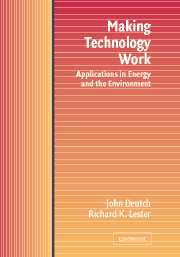Book contents
- Frontmatter
- Contents
- Preface
- 1 Introduction
- 2 Gasohol
- 3 Solar Thermal, Windpower, and Photovoltaic Technologies
- 4 Electricity from Coal
- 5 Controlling Acid Rain from Coal-fired Power Plants
- 6 Greenhouse Gases and Global Warming
- 7 Nuclear Power and Its Fuel Cycle
- 8 Managing Nuclear Waste
- 9 Nuclear Power and Weapons Proliferation
- 10 Natural Gas
- 11 Safety and Risk: Examples from the Liquefied Natural Gas and Nuclear Industries
- 12 Synthetic Fuels
- 13 Fuel Cells For Automobiles
- 14 Energy Models and Statistics
- 15 The Government's Role in Innovation
- 16 Conclusions
- Index
7 - Nuclear Power and Its Fuel Cycle
Published online by Cambridge University Press: 10 December 2009
- Frontmatter
- Contents
- Preface
- 1 Introduction
- 2 Gasohol
- 3 Solar Thermal, Windpower, and Photovoltaic Technologies
- 4 Electricity from Coal
- 5 Controlling Acid Rain from Coal-fired Power Plants
- 6 Greenhouse Gases and Global Warming
- 7 Nuclear Power and Its Fuel Cycle
- 8 Managing Nuclear Waste
- 9 Nuclear Power and Weapons Proliferation
- 10 Natural Gas
- 11 Safety and Risk: Examples from the Liquefied Natural Gas and Nuclear Industries
- 12 Synthetic Fuels
- 13 Fuel Cells For Automobiles
- 14 Energy Models and Statistics
- 15 The Government's Role in Innovation
- 16 Conclusions
- Index
Summary
No technological system more dramatically illustrates the central themes of this book – the complexity of real world applications of technology and the pitfalls of ignoring the social, political, and environmental dimensions of innovation – than nuclear power. Once widely seen as an energy source of almost unlimited potential, nuclear power is today expanding in just a handful of countries. In most countries with operating nuclear power stations there are no plans to build additional nuclear plants, and some countries have made formal decisions to phase out their existing reactors as quickly as possible.
Despite its limited growth prospects, nuclear power is today playing an important role around the world with nearly 440 plants supplying 17% of the world's electricity. In some countries, the level of dependence is much higher. France derives 76% of its electricity from nuclear power, and other heavily nuclear-reliant countries include Belgium, Japan, and South Korea (see Table 7.1). The world's largest nuclear power program is in the United States, where more than 100 plants provide 20% of the nation's electricity. Keeping these plants operating safely, reliably, and economically is a vital task for private firms and governments around the world. But with few new nuclear plants being built, almost every energy forecast projects a gradual decline in the nuclear share of world electricity supplies.
- Type
- Chapter
- Information
- Making Technology WorkApplications in Energy and the Environment, pp. 109 - 133Publisher: Cambridge University PressPrint publication year: 2003

